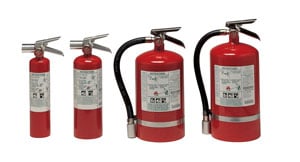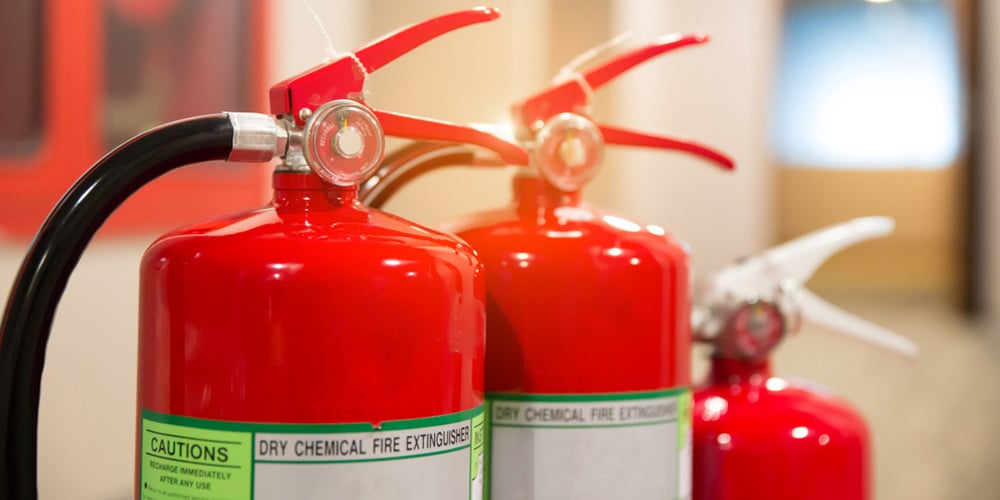
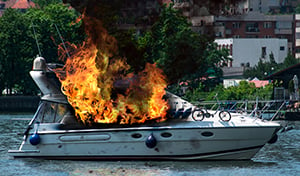
Onboard fires are one of the most common reasons boaters are forced to abandon ship. In spite of the protection that fire extinguishers provide, most boaters tend to ignore them. Along with providing information on the number of extinguishers required, classes of fires and types of extinguishing agents, this article also covers new portable fire extinguisher regulations that were enacted in April of 2022.
- Minimum USCG Fire Extinguisher Requirements
- Types of Fires
- Fire Extinguisher Ratings
- Do You Need a New Fire Extinguisher?
- Fire Extinguisher Agents
- PASS: Fighting a Fire with a Portable Extinguisher
- Automatic Fixed-Mount Systems
- Automatic Engine Shutdown
- Conclusion
Minimum USCG Fire Extinguisher Requirements
The Coast Guard requires from one to three extinguishers on pleasure boats, depending on whether they have enclosed engine compartments and if there is a permanently-mounted fixed extinguisher system in the engine room. The minimum number of extinguishers required depends on boat length. Some readers will notice that the minimum requirements that appear immediately below do not include the old USCG extinguisher type designations, such as “B-1” or “B-II”. This is because the new regulations are based on the fire extinguisher designations employed by UL (Underwriters Laboratories). Later in this article, (See table under New Portable Fire Extinguisher Requirements) we list allowable combinations of extinguishers that meet the minimum requirement and in some cases will provide enhanced protection for your boat.
- Less than 26': One 5-B size extinguisher. Fire extinguishers are not required on outboard-powered pleasure boats less than 26' in length, not carrying passengers for hire, without permanently-installed fuel tanks, that do not have spaces where explosive or flammable gasses or vapors can collect.
- From 26' to less than 40': Two 5-B extinguishers
- From 40' to 65': Three 5-B extinguishers
- Greater than 65': One or more 20-B. Number required depends on gross tonnage.
While simply meeting the minimum requirements will enable you to pass a Coast Guard inspection, we suggest you go beyond what the government mandates and purchase extinguishers according to your boat’s layout. We recommend at least one in the cockpit, one in each stateroom and one in the galley area—which should be reachable even if the stove is on fire. Statistically speaking, onboard fires double in size every seven seconds, so having a fire extinguisher readily available may make the difference between inconvenience and catastrophe.
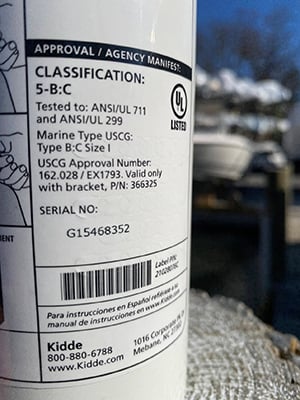
Example of new labeling on UL-listed, 5-B:C extinguisher. While the USCG type designation does appear on the label, for boats 2018 and newer, it is the UL designation that counts. Photo courtesy BoatUS.
Types of Fires: Class A, B and C
- Class A Fires: Include all combustible solid materials, such as paper, wood, cloth, rubber, and many plastics including the fiberglass reinforced plastic used for decks and hulls. ( Memory device: Class A fires leave an Ash.)
- Class B Fires: Include all flammable liquids, including stove alcohol, grease, gasoline, diesel, kerosene, oil, oil based paint, teak oil, paint thinners, acetone, varnishes, and flammable gases or fumes. (Memory device: Class B fires Boil.)
- Class C Fires: Include all energized electrical equipment. Class C fires are identified for their potential to electrocute or shock a person if you apply electrically conducting water-based extinguishing agents. Turning off the electricity is the top priority when fighting a Class C fire. Usually you can turn off the main battery switch. Cutting the power will change the status of a Class C fire to a Class A and/or B fire. (Memory device: Class C fires have a Charge.)
Fire Extinguisher Ratings
Labeling for extinguishers includes ratings that reflect an extinguisher’s ability to combat the classes of fires described above. UL uses letters to denote the types of fires an extinguisher is capable of fighting; and numbers that refer to the fire fighting “capacity” relative to other extinguishers. For example, a 1-A, 10-B:C extinguisher is effective on Class A, B, and C fires, and a 40-B:C extinguisher has four times the extinguishing capacity as a 10-B:C extinguisher.
Until recently, fire extinguisher labels also included U.S. Coast Guard ratings, which differed from the ratings employed by UL. Coast Guard terms such as “B-1” and “B-II” only refer to the weight of the extinguishing agent, whereas UL labeling denotes the firefighting ability.
Do You Need New Fire Extinguishers?
On April 20, 2022 new fire extinguisher regulations took effect. How the new regulations affect you depends on the model year of your boat. For boats up to 65', the minimum USCG requirement is from one to three 5-B extinguishers depending on boat length. Allowable substitutions appear in parentheses. The table and italicized text appears courtesy of BoatUS.
| Vessel Length | No Fixed System | With Approved Fixed System |
|---|---|---|
| Less than 26’ | One 5-B (or One 10-B) | None |
| 26’ to less than 40’ | Two 5-B (or Two 10-B or One 20-B) | One 5-B or One 10-B |
| 40’ to 65’ | Three 5-B (or Three 10-B or One 20-B and One 5-B or One 20-B and one 10-B) | Two 5-B or Two 10-B or One 20-B |
Note: Many retailers offer 10-B and 20-B class fire extinguishers, which may be a good choice as they exceed USCG minimum carriage requirements for boats under 26 feet while giving boaters more extinguishing coverage. For boats 26 feet or larger, however, having one 10-B aboard does not equal two 5-Bs.
If you own a boat that is model year 2018 or newer, you may need to replace your fire extinguishers.
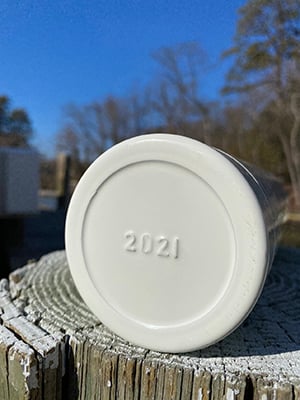
Extinguishers must not be over 12 years old according to the date stamped on the bottle. Photo courtesy BoatUS.
In addition to meeting the carriage requirements for the correct number of extinguishers for the size of your boat, they must be labeled as 5-B, 10-B or 20-B. Extinguishers labeled with B-I or B-II only are no longer acceptable.
Extinguishers must not be more than 12 years old according to the date of manufacture stamped on the bottle.
You only have to get new extinguishers if they are no longer serviceable. Good serviceable conditions are as follows:
- If the extinguisher has a pressure gauge reading or indicator, it must be in the operable range or position
- The lock pin is firmly in place
- The discharge nozzle is clean and free of obstruction
- The extinguisher does not show visible signs of significant corrosion or damage
2017 Model Year Boats and Older (between 1953-2017):
- You may keep your extinguishers labeled B-I and B-II as long as they are still serviceable, but
- If there is a date stamped on the bottle, extinguishers must not be more than 12 years old according to that date.
See the decision making flow chart at the bottom of this article.
Fire Extinguishing Agents
Water: Good for Class A fires. Extinguishers are heavy, difficult to store, and are NOT for use on flammable liquid or electrical fires.
Carbon Dioxide (CO2): Good for Class B and Class C fires. No residue. Easy to use. Useful only in confined interior spaces. Does not cool fire.
HFC-227: While still available (as of May, 2022), HFC-227 will shortly be phased out in favor of extinguishers that use 3M’s Novec™ 1230 extinguishing agent. This change is being made in response to meet new environmental regulations enacted by the United States Congress in 2020.
Novec™ 1230: This 3M agent is an environmentally-sustainable replacement for HFC-227 or FM200. No potential damage to the ozone layer or global warming potential. Effective on all fire classes and leaves no residue after use.
Halotron 1: EPA-approved. Safe for computers, electronics, even clean rooms, and leaves no residue after use.
Dry Chemical: Low toxicity. Inexpensive. Effective on Class B and Class C fires. Not effective on Class A fires. Difficult to clean up.
Tri-Class Dry Chemical: Low toxicity. Inexpensive. Effective on Class B and Class C fires. Moderately effective on Class A fires. Difficult to clean up. Corrosive. Not a good choice for helm or nav station.
Aqueous Foam: This relatively new technology is extremely easy to use effectively on Class A, B, and C fires. Avoid excessive skin or eye contact.
PASS: Fighting a Fire with a Portable Extinguisher
Typical fire extinguishers have a discharge time of only about 10 to 12 seconds, so you have to use them before the fire gets too large. Deep-seated fires that seem to be out may flare up again. The short discharge time, combined with the possibility of reflash, are important reasons to carry extra extinguishers onboard.
To quickly remember how to fight a fire with a handheld fire extinguisher, use this easy-to-remember acronym called PASS:
- Pull the pin
- Aim the fire extinguisher
- Squeeze the two handles together
- Sweep across the base of the flames
Automatic Fixed-Mount Fire Extinguisher Systems
According to the Coast Guard, 90 percent of boat fires start in the engine room. Based on actual claims of the insurance division of BoatUS, electrical wiring fires account for 55 percent of all boat fires, followed by engine and transmission fires at 24 percent, DC wiring fires at 12 percent and fuel leaks at eight percent.
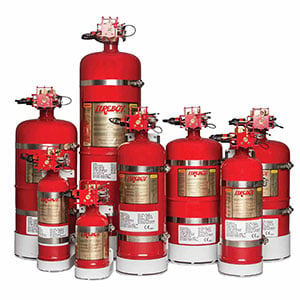
Fixed-mount fire extinguishers should be sized according to the volume in cubic feet of the engine space. Install the extinguishers either horizontally or vertically.
Boaters can protect themselves with periodic maintenance of their mechanical and electrical systems. This includes keeping water intake lines free of debris and weeds, replacing raw water pump impellers, and keeping exhaust manifolds and risers free from blockages caused by rust deposits.
Unfortunately, fires do happen even to well-cared-for vessels. Often, when an engine starts to sputter or someone sees or smells smoke, the first impulse is to open the door or hatch to the engine compartment. This well-intentioned action may result in an inrush of oxygen that stokes a smoldering fire into a mass of flames.
Fireboy-Xintex Manual and Automatic Clean Agent Fire Extinguishers prevent the scenario described above. They fight fires from the start, by triggering automatically when a temperature sensor reaches 175°F. In addition to automatic operation, they can be discharged manually by pulling an optional manual release cable when you discover the fire. Cable lengths range from 6 to 40 feet.
Fireboy-Xintex systems release a clean agent (currently HFC-227 which is being replaced by 3M’s Novec™ 1230) for about 10 seconds, smothering the fire and leaving no residue behind. A dash mounted LED display (fits a 2 1/8" cutout) shows the engine compartment extinguisher’s charged/discharged status. A remote 85dB horn also sounds when the extinguisher is low on pressure or has discharged.
HFC-227 and 3M’s Novec™ 1230 extinguishing agents won’t damage equipment or cause diesel engines to stall. In regard to crew safety however, while Novec™ 1230 is not dangerous and it is considered safe for use in occupied spaces, HFC-227 can cause respiratory illness and/or be lethal to crew caught in the vicinity of a discharge. This underscores the importance of automatic engine shutdown systems, particulary for boats equipped with engine room fire extinguishers that use HFC-227 as the agent.
Automatic Engine Shutdown
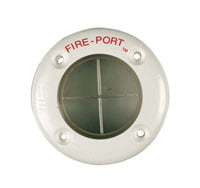
The Fire Port allows you to safely fight an engine room blaze without opening the hatch.
If there is an engine room fire while you’re under way and the automatic system discharges, the engine, generator and bilge blower systems need to be immediately shut down, either by crew or (preferably) by an electronic device. Otherwise, the diesel keeps chugging away, feeding oxygen to the blaze and sucking the fire-retardant out of the compartment (and into the engine air intakes or out the ventilation exhaust fans), rendering your fire-fighting system ineffective. Automatic engine shutdown units take care of this in an instant.
For small boats, an inexpensive alternative to automatic systems is the Fire Port, a clear 2 11/16" diameter plastic port that you can install in a hatch, engine cover or bulkhead. You can see inside the engine compartment without opening the hatch, and if you see evidence of a fire, simply knock out the small plastic window with the nozzle of your fire extinguisher and safely blast away. Halotron I portable fire extinguishers are excellent for this application, since they leave no residue and fight the fire by removing oxygen.
Conclusion
Government regulations are often confusing. We hope this article has helped you to understand the regulations as they apply to your boat. The following flow chart is provided courtesy of BoatUS.

